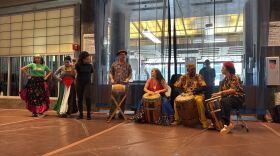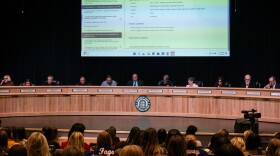San Diego Unified will soon triple its number of campuses that offer on-site wraparound services, from health care to food pantries, for some of the district’s most vulnerable students.
They’re known as community schools: Through family engagement and partnerships with service providers, the district hopes kids will miss fewer days of school — and that its dwindling enrollment numbers will improve.
Services offered can differ at each campus depending on the community’s need, but can include access to free food, health care, counseling, dental services, tutoring, after-school programs and parenting education.
Ten additional campuses — six elementary schools, one middle school and three high schools — will become a community school this upcoming year. Another fifteen will join the pipeline, meaning officials will prepare to transform them into community schools in the coming years.
Already, five campuses — including Hoover High, where the district held an event last week to spotlight its transformation — have become community schools.
Next year, the district will have 15 community schools. Another 10 have been selected for the next cohort.
The move is part of a more than $4 billion statewide effort to convert thousands of public schools into community schools as a way to combat the damage incurred by the COVID-19 pandemic, which exacerbated learning barriers such as poverty, food insecurity and others. Research shows community schools, which have existed for decades, have a positive effect on graduation rates, academic progress, attendance and a reduction in disciplinary incidents.
As inewsource previously reported, nearly 8,500 San Diego Unified students are unhoused as unsheltered homelessness has dramatically increased in the region. The district also saw its already declining enrollment rates worsen during the pandemic: It saw about a 3.4% drop during 2021-22, and another 1% decrease the following year.
But there still remain unanswered questions about San Diego Unified’s growing model — namely, how it will fund community schools beyond the state’s seven-year investment and whether data shows it’s making a difference.
Upcoming community schools
Ten more San Diego Unified campuses will be turned into community schools during the 2023-24 school year.
- Bell Middle School, Paradise Hills
- Crawford High School, El Cerrito
- Lincoln High School, Lincoln Park
- Morse High School, Skyline
- Sherman Elementary School, Sherman Heights
- Burbank Elementary School, Barrio Logan
- Cherokee Point Elementary School, City Heights
- Chollas Mead Elementary, Chollas View
- Fay Elementary School, City Heights
- Lafayette Elementary School, Clairemont
The district has received a nearly $13 million grant to support eight community schools through the 2026-27 year. But at least 30 campuses are ultimately slated to become community schools, and San Diego Unified — which is projecting a roughly $129 million deficit during the 2024-24 school year and $182 million in 2025-26 — must also fund a share of the expenses.
Its share of costs for the community schools is expected to increase significantly during that same time period, with a more than $10 million projection by 2026-27.
Still, officials signed an agreement in April with the San Diego Education Association, the district’s teachers union, promising “community school initiatives will be sustained to the fullest extent possible if grant funding expires.” District spokesperson Maureen Magee also told inewsource that San Diego Unified will need to provide the state with a funding plan by the end of the 2024-25 year.

Jason Babineau, a senior director at the district, said “it is going to take time for things to shift.” Education initiatives can often change when desired results don’t come quick enough, he said, but the state’s willingness to commit for several years makes this effort different.
“With this particular commitment, we actually now have time to make the appropriate adjustments that we need to make to yield the results that we need to have,” Babineau said during last week’s event at Hoover.
How successful San Diego Unified’s community schools are remains unknown so far. The state sent school districts its first round of grant checks last year without creating metrics for the community schools. And when San Diego Unified board President Sabrina Bazzo last week asked Hoover Principal Tracey Makings about whether any changes in attendance and enrollment could be attributed to its transformation into a community school, Makings said that couldn’t be determined yet.
Thirty-five percent of students at Hoover were chronically absent — meaning they missed a tenth or more of all school days — during 2021-22, the most recent year for which data is available. That’s the highest it’s been in at least five years.
“I think we just have to set a baseline and measure from this point forward,” Makings said.
Magee said community schools will use enrollment and absenteeism rates from their first year of implementation as a baseline to measure their success.

But Makings said addressing chronic absenteeism goes beyond tracking attendance. It will require connecting with families, making sure they know the resources the school offers and identifying critical information the school should know about them in order to help, she said.
As a community school, Hoover now offers a variety of resources on campus. There’s a community garden and a food pantry, a boon for the 80% of Hoover families who live in poverty. More than 20,000 people have used the pantry and 50,000 pounds of food have been delivered to campus since February.
Mental health services are available in partnership with Rady’s Children’s Hospitals, and medical care is offered by La Maestra Community Health.
Richard Gijon, Hoover High’s community schools site coordinator, told inewsource that plans to add more services are underway. By the fall, the school aims to open a closet with clothing and basic toiletries and a laundry room where students can wash their clothes. It also is working with La Maestra to offer rent and utility assistance.
After about a year since its transformation into a community school, Hoover officials have heard from about 2,200 students, 1,700 families, 200 staff members and formed connections with over 30 community partners.







